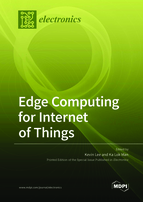Edge Computing for Internet of Things
A special issue of Electronics (ISSN 2079-9292). This special issue belongs to the section "Networks".
Deadline for manuscript submissions: closed (15 January 2022) | Viewed by 31333
Special Issue Editors
Interests: Internet of Things; cloud computing; robotics; embedded systems
Special Issues, Collections and Topics in MDPI journals
Interests: wireless sensor networks; Internet of Things; Artificial Intelligence and photovoltaic
Special Issues, Collections and Topics in MDPI journals
Special Issue Information
Dear Colleagues,
The Internet of Things is becoming an established technology, with devices being deployed in homes, workplaces, and public areas at an increasingly rapid rate. IoT devices are the core technology of smart homes, smart cities, intelligent transport systems and the promise to optimise travel, reduce energy usage and improve quality of life. With the prevalence of IoT, the problem of how to manage the vast volumes, wide variety and type of data generated, and erratic generation patterns is becoming increasingly clear and challenging.
This Special Issue focuses on solving this problem through the use of edge computing. Edge computing offers a solution to managing IoT data through the processing of IoT data close to the location where the data are being generated. Edge computing allows computation to be performed locally, thus reducing the volume of data that need to be transmitted to remote data centers and Cloud storage. It also allows decisions to be made locally without having to wait for Cloud servers to respond.
We encourage papers in all areas related to this topic, including software architectures, systems, IoT devices, edge computing devices and fog computing.
Dr. Kevin Lee
Prof. Dr. Ka Lok Man
Guest Editors
Manuscript Submission Information
Manuscripts should be submitted online at www.mdpi.com by registering and logging in to this website. Once you are registered, click here to go to the submission form. Manuscripts can be submitted until the deadline. All submissions that pass pre-check are peer-reviewed. Accepted papers will be published continuously in the journal (as soon as accepted) and will be listed together on the special issue website. Research articles, review articles as well as short communications are invited. For planned papers, a title and short abstract (about 100 words) can be sent to the Editorial Office for announcement on this website.
Submitted manuscripts should not have been published previously, nor be under consideration for publication elsewhere (except conference proceedings papers). All manuscripts are thoroughly refereed through a single-blind peer-review process. A guide for authors and other relevant information for submission of manuscripts is available on the Instructions for Authors page. Electronics is an international peer-reviewed open access semimonthly journal published by MDPI.
Please visit the Instructions for Authors page before submitting a manuscript. The Article Processing Charge (APC) for publication in this open access journal is 2400 CHF (Swiss Francs). Submitted papers should be well formatted and use good English. Authors may use MDPI's English editing service prior to publication or during author revisions.
Keywords
- Internet of Things
- Edge computing
- Fog computing
- Cloud computing
- 5G wireless
- Local processing
- Big data
- Embedded systems
- Data processing
- Gateways
- Data analysis
- Data reduction
- Real-time data processing







